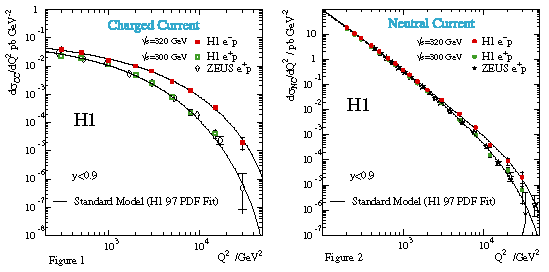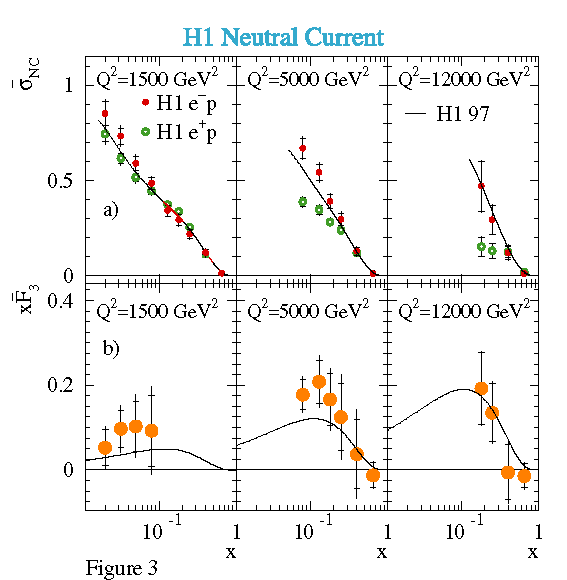Measurement of Neutral and Charged Current Cross Sections in Electron-Proton
Collisions at High Q2
|
The H1 experiment at HERA was designed to measure the
details of proton sub-structure at the very highest energies using electrons
(e-) and positrons (e+), as probes. Several years
of data taking have allowed these measurements to be made revealing how
the proton components, quarks and gluons behave. Current
theory, the Standard Model, states that the interaction, or cross
section, of electrons scattering off quarks, Deep Inelastic Scattering,
(DIS) is different than for positrons. This difference is due to the
existence of the weak force which becomes visible when the momentum
transfers involved (Q2) are of similar size to the masses of
the particles which propagate the force, namely the W and Z
bosons. Two reactions have been measured in this paper: The Neutral
Current (NC) process where an electron scatters off a quark
via exchange of the electrically neutral photon or
Z, and the Charged
Current (CC) reaction whereby the electron scatters via exchange
of a charged W and converts to an unseen neutrino. This paper constitutes
the first high statistics measurement of electron induced cross sections
at high Q2 using data collected during 1998 and 1999. The measurement
spans the range in Q2 from 150 GeV2 up to 30000 GeV2.
The cross sections are compared with an earlier measurement by H1 using
positrons in the same kinematic range.

The CC cross sections are found to be up to a factor of 10 larger for
electron scattering and are shown in the fig. 1 comparing the solid points
to the open points. This difference is understood to be due to the fact
that the charged W particle picks out only oppositely charged quarks
from the proton and since there are more positively charged quarks, the
electron cross section is larger. It is enhanced by the fact that
intrinsic angular momentum can be transferred more effectively in e-p
scattering. The measurements are found to be in agreement with the Standard
Model expectations which take the above effects into account and are indicated
by the smooth curves in the figure.
The NC cross sections are up to a factor of four larger than for positron
scattering at high Q2 as shown in fig. 2. Although the NC photon
exchange process is blind to the sign of the quark charge, the Z
exchange is sensitive to the weak charge of the quarks which reflect the
coupling to the Z. This is exploited to make a measurement of the
xF3 structure function which is derived from the difference
between electron and positron NC cross sections. This structure function
is mainly sensitive to the valence quarks, those that carry the
quantum numbers of the proton, and as such constitutes the first measurement
of this structure function at high energy.
 Fig. 3a shows the
measured e+p and e-p cross sections at three different
Q2 values as a function of x, the momentum fraction of
the proton. The e+p and e-p cross sections become
increasingly asymmetric as Q2 increases, indicating that Z
exchange becomes more prevalent. However, as Q2 increases the
statistical precision also decreases. The differences are shown in fig.
3b as xF3, which is found to be in agreement with the
prediction based on e+p data and thus provides independent confirmation
of the flavour decomposition of the proton. Despite the large uncertainties
on the data, these new measurements confirm the Standard Model in a new
kinematic region. It is clear that continued operation of HERA and the
H1 experiment is required to improve the precision of these measurements.
Fig. 3a shows the
measured e+p and e-p cross sections at three different
Q2 values as a function of x, the momentum fraction of
the proton. The e+p and e-p cross sections become
increasingly asymmetric as Q2 increases, indicating that Z
exchange becomes more prevalent. However, as Q2 increases the
statistical precision also decreases. The differences are shown in fig.
3b as xF3, which is found to be in agreement with the
prediction based on e+p data and thus provides independent confirmation
of the flavour decomposition of the proton. Despite the large uncertainties
on the data, these new measurements confirm the Standard Model in a new
kinematic region. It is clear that continued operation of HERA and the
H1 experiment is required to improve the precision of these measurements.
Last Update 11.12.2000

 Fig. 3a shows the
measured e+p and e-p cross sections at three different
Q2 values as a function of x, the momentum fraction of
the proton. The e+p and e-p cross sections become
increasingly asymmetric as Q2 increases, indicating that Z
exchange becomes more prevalent. However, as Q2 increases the
statistical precision also decreases. The differences are shown in fig.
3b as xF3, which is found to be in agreement with the
prediction based on e+p data and thus provides independent confirmation
of the flavour decomposition of the proton. Despite the large uncertainties
on the data, these new measurements confirm the Standard Model in a new
kinematic region. It is clear that continued operation of HERA and the
H1 experiment is required to improve the precision of these measurements.
Fig. 3a shows the
measured e+p and e-p cross sections at three different
Q2 values as a function of x, the momentum fraction of
the proton. The e+p and e-p cross sections become
increasingly asymmetric as Q2 increases, indicating that Z
exchange becomes more prevalent. However, as Q2 increases the
statistical precision also decreases. The differences are shown in fig.
3b as xF3, which is found to be in agreement with the
prediction based on e+p data and thus provides independent confirmation
of the flavour decomposition of the proton. Despite the large uncertainties
on the data, these new measurements confirm the Standard Model in a new
kinematic region. It is clear that continued operation of HERA and the
H1 experiment is required to improve the precision of these measurements.